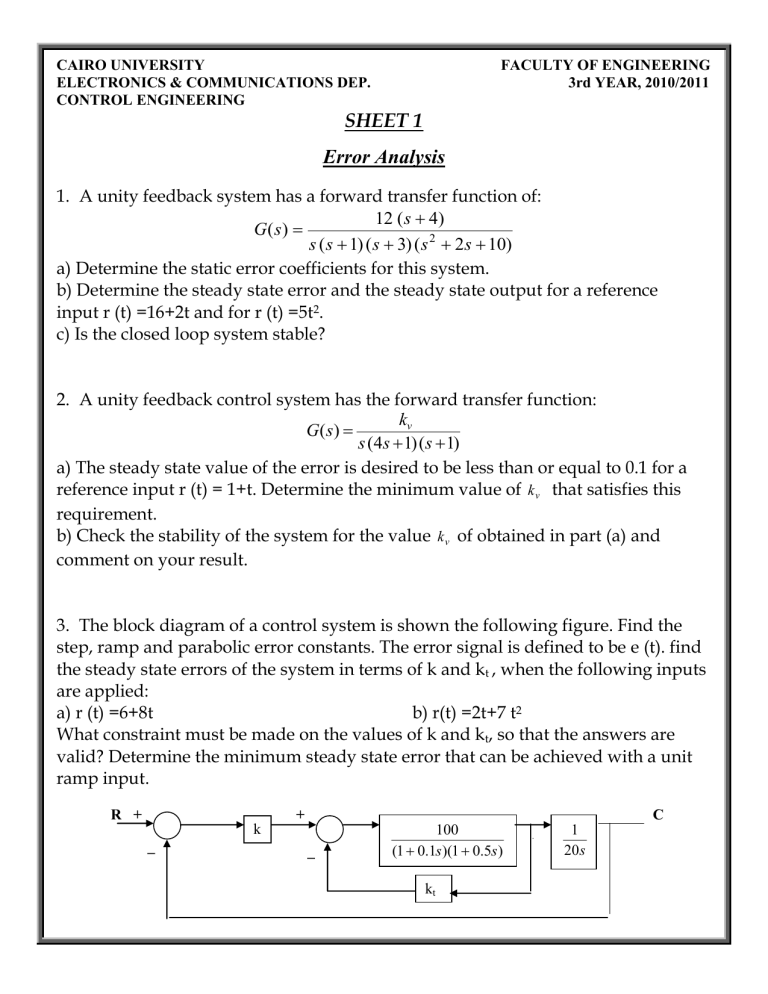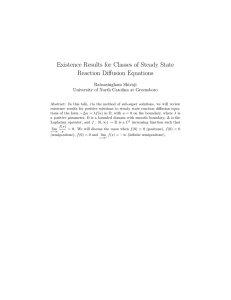
CAIRO UNIVERSITY ELECTRONICS & COMMUNICATIONS DEP. CONTROL ENGINEERING FACULTY OF ENGINEERING 3rd YEAR, 2010/2011 SHEET 1 Error Analysis 1. A unity feedback system has a forward transfer function of: 12 ( s 4) G( s) s ( s 1) ( s 3) ( s 2 2s 10) a) Determine the static error coefficients for this system. b) Determine the steady state error and the steady state output for a reference input r (t) =16+2t and for r (t) =5t2. c) Is the closed loop system stable? 2. A unity feedback control system has the forward transfer function: kv G( s) s (4s 1)( s 1) a) The steady state value of the error is desired to be less than or equal to 0.1 for a reference input r (t) = 1+t. Determine the minimum value of k v that satisfies this requirement. b) Check the stability of the system for the value k v of obtained in part (a) and comment on your result. 3. The block diagram of a control system is shown the following figure. Find the step, ramp and parabolic error constants. The error signal is defined to be e (t). find the steady state errors of the system in terms of k and kt , when the following inputs are applied: a) r (t) =6+8t b) r(t) =2t+7 t2 What constraint must be made on the values of k and kt, so that the answers are valid? Determine the minimum steady state error that can be achieved with a unit ramp input. R + + C k _ _ 100 (1 0.1s )(1 0.5s ) kt 1 20 s 4. The block diagram of a feedback control system is shown in the figure. The error signal is defined to be e (t). a) Find the steady state error of the system in terms of k and kt when the input is a unit ramp function. Give the constraints on the values of k and kt so that the answer is valid. Let n (t) =0 for this part. b) Find the steady state value of c (t) when n (t) is a unit step function. Let r (t) =0 R(s) + N(s) + 1+0.02S+ + s E(s) - k s ( s 25) 2 c(s) kt s 5. (Final 98) The following Figure shows a block diagram of a cascade control system designed to counteract disturbance D. (a) Initially consider the situation with no cascade loop, i.e. link AB open. State the type of the system and find the static error coefficients in terms of loop gains. Determine the limiting value of the gain (K1K2) in order to maintain stable operation. Let K2 = 50, Find the value of K1 that gives steady state output due a unit step disturbance equal (0.1). Link AB is closed to implement the cascade loop and K1, K2 are fixed at the values obtained in part (a). Find the steady state change in output due to a unit step disturbance. D + R + _ + Σ k1 + Σ _ k2 Σ A 1 (1 2S )(1 3S ) B 1 1 10S C 6. A control system with unity feedback has the forward transfer function: G( s) k ( s 1) ( s 4) 2 a) Evaluate the error series when the input r (t) = 6+3t is applied, hence find the value of the steady state error at t=2 sec. in terms of k. b) Find the minimum value of the steady state error that can be achieved by varying the value of k for a unit step input. 7. (Final 2001) A control system with unity feedback has the transfer function: G(S ) K ( S 1)( S 2 2S 2) (a) Evaluate the error series when the input r (t) = 10 + 6t + e-5t is applied. (b) Find the value of the error (in terms of K) at t = 3 sec. (c) Find the minimum value of steady state error that can be achieved by varying the value of K for a unit step input. Summary: A. For the continuous time system: R(S) E(S) + R( S ) 1 G( S ) H (S ) E (S ) E (S ) exact expression of the error ess lim SE(S ) tlim e(t ) or you can easily get it from the following table: s0 H(S) R(S) ess Error const. value ess due to step input M S M 1 K p K p lim G(S ) H ( S ) position error constant ess due to ramp input M S2 M Kv Kv lim SG(S ) H (S ) velocity error constant ess due to parab input M S3 M Ka Ka lim S 2G(S ) H (S ) acceleration error constant s 0 s 0 s 0 Yss (S ) lim SY ( S ) Rss ( S ) ess s 0 B. For a continuous time system with a disturbance: Gp (S ) D( S ) Y ( S ) due to disturbance D(S) 1 G p ( S )Gc ( S ) H ( S ) E(S) R(S) + ess due to dist. lim SY (S ) due to disturbance D(S) s 0 Y (S ) Y (S ) due to input R(S) Total G p ( S )Gc ( S ) 1 G p ( S )Gc ( S ) H ( S ) G p ( S )Gc ( S ) 1 G p ( S )Gc ( S ) H (S ) R( S ) D(S) Gc(S) + - R( S ) Gp (S ) 1 G p (S )Gc (S ) H (S ) C. Error series: oo r (t ) e s (t ) C 0 r (t ) C 1 r (t ) C 2 2 where : o Y(S) G(S) dF (S ) d 2 F (S ) C 0 lim F (S ) , C 1 lim , C 2 lim s 0 s 0 s 0 dS dS 2 E (S ) 1 and F (S ) R (S ) 1 G (S )H (S ) H(S) D( S ) + Y(S) Gp(S)

